KIN 480 Nervous System
1/79
There's no tags or description
Looks like no tags are added yet.
Name | Mastery | Learn | Test | Matching | Spaced |
|---|
No study sessions yet.
80 Terms
How do interneurons work?
Can be excitatory or inhibitory, postsynaptic neuron only fire if both E and I combine to meet threshold
Temporal & Summation with Excitatory
Both will increase the chance of an action potential
Temporal & Summation with Inhibitory
Both will decrease the chance of an action potential
Autogenic facilitation
excites the muscle that contains the sensor
Autogenic inhibition
inhibits the muscle that contains the sensor
Antagonistic facilitation
excites the antagonist muscle
Antagonistic inhibition
inhibits the antagonist muscle
Muscle spindles location
interspersed among muscle fibers (inside muscle)
What do muscle spindles respond to?
- Muscle velocity
- Muscle length
What can muscle spindles cause?
- Autogenic facilitation (excite same muscle)
- Antagonistic inhibition (inhibit antagonist)
What reflex is associated with muscle spindles?
Stretch reflex (excites quad, inhibits hamstrings)
Golgi tendon organ location
near the muscle-tendon junction
What do golgi tendon organs respond to?
muscle tension
What do golgi tendon organs cause?
-autogenic inhibition (inhibit same)
- antagonistic facilitation (excite antagonist)
GTOs and coordination
GTOs may be a factor in uncoordinated responses in untrained individuals
Ruffini endings
Sensory receptor in joint capsule that responds to change in joint position
Pacinian corpuscles
Sensory receptor in skin stimulated by pressure
Free nerve endings
Pain receptors widely dispersed in body
What do joint sensory receptors do (Ruffini, pacinian, free nerve endings)?
Help kinesthetic sense and proprioception
kinesthetic sense
where your segments are in space
Arthrogenic Muscle Inhibition
diminished ability to produce muscle forces due to inhibition of muscle that occurs after injury
will Arthrogenic Muscle Inhibition occur if there is no pain?
yes. this is independent from pain
Consequences of Arthrogenic Muscle Inhibition
after injury, muscles may become weaker, and may not be able to produce as much force.
May need to rehabilitate muscles even if it is not a muscle injury.
Restrictions to ROM at a joint
- bony structures
- soft tissues surrounding joint
- ligaments
- muscle length of antagonist
- neurological mechanisms during dynamic movements (stretch reflex, arthrogenic muscle inhibition)
What is stretched to increase ROM?
- Fascia, epimysium, perimysium, endomysium and tendons
- NOT muscles fibers
What is best practice for stretching a muscle?
- after a workout (warm)
- long period of time (30-60seconds)
- under a low load
static stretching
hold the stretch to elicit response from GTO ( causing autogenic inhibition)
ballistic stretching
bouncing can activate stretch reflex (autogenic facilitation) which may reduce ROM or damage to muscle fibers
is static or ballistic stretching safer?
static
dynamic stretching
functional movements that mimic the movement of the activity you're about to perform, taking advantage of fun ROM
PNF Stretching meaning
Proprioceptive Neuromuscular Facilitation
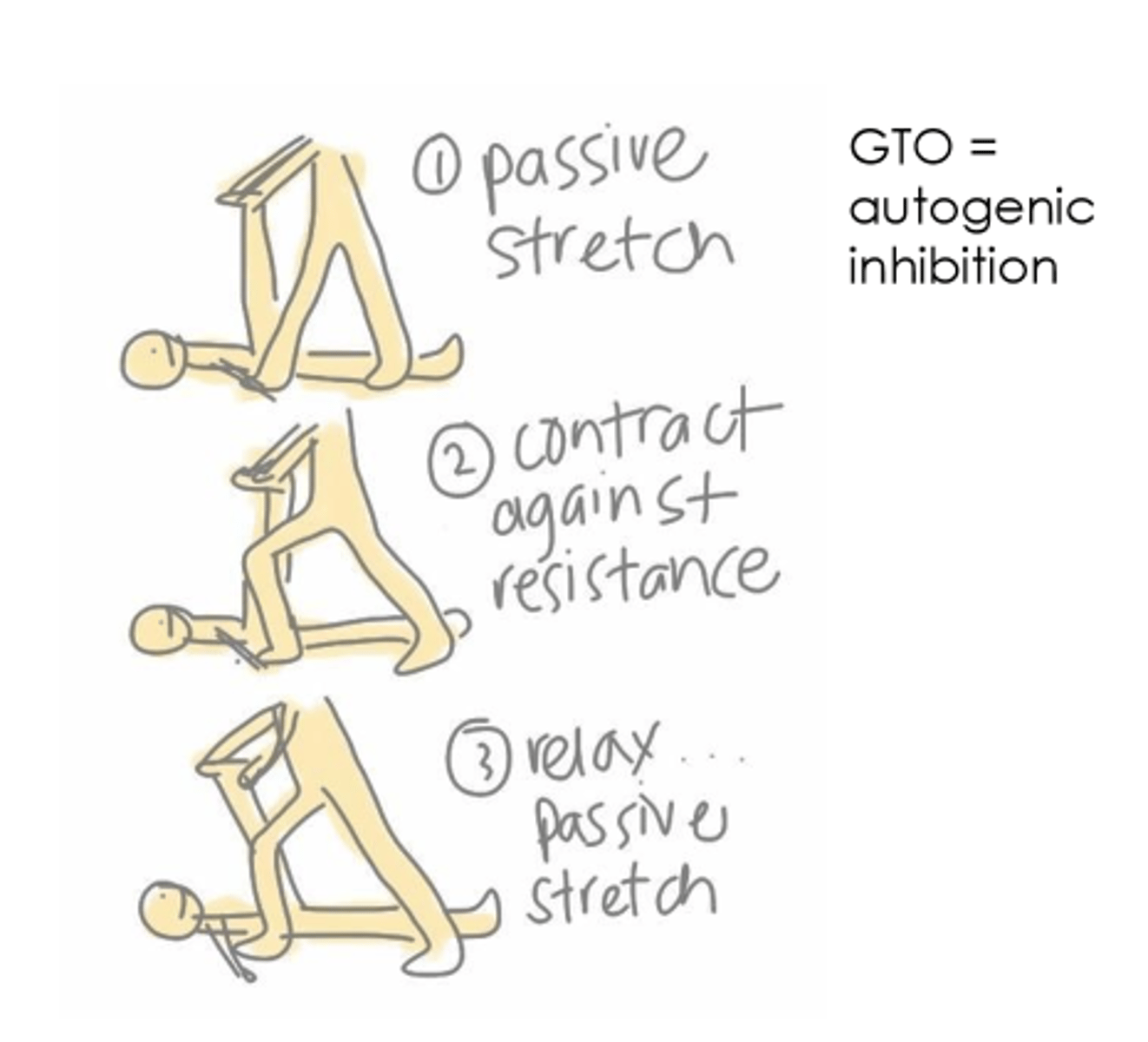
PNF Stretching
- stimulates relaxation of the muscle fibers to allow greater stretch of connective tissue
- both antagonist inhibition and autogenic inhibition can be used
Proprioceptive Training
training specifically designed to activate the nervous system
Examples of Proprioceptive Training
- passive movement training
- sensorimotor stimulation
- vibrotactile stimulation
- somatosensory discrimination training
- balance training
- agility training
Motor unit
A motor neuron and all of the muscle fibers it innervates
Action potential definition
localized depolarization. voltage switches (becoming more positive on the inside, more negative on the outside)
What happens when a nerve action potential (AP) arrives at the axon terminal?
Calcium channels open and calcium is released.
What does calcium cause in the axon terminal?
Calcium causes synaptic vesicles to fuse with the axon terminal membrane.
What is released into the synaptic cleft after synaptic vesicles fuse?
Acetylcholine is released into the cleft.
What happens to calcium after acetylcholine is released?
Calcium is pumped out of the terminal.
What occurs when acetylcholine binds to the motor end plate?
It allows sodium in and potassium out, leading to depolarization. (pump K in)
What does depolarization initiate in muscle cells?
It initiates a muscle action potential (AP) that causes muscle contraction.
Nerve to Muscle AP step 1
nerve action potential at axon terminal opens calcium channels and allows calcium ions to enter axon terminals
step 2
calcium ions cause synaptic vesicles to fuse with the axon terminal membrane
step 3
ACh is released into the synaptic cleft. Calcum ions are pumped out of axon terminal
step 4
ACh binds to motor end plate and opens the channels that pump Na in and K out. Causes local depolarization of the motor end plate
step 5
depolarization causes action potential that propagates along the sarcolemma and results in muscle contraction
What affects muscle precision?
number of fibers per motor unit
less fibers/MU = more precision
What determines fiber type
the motor unit neuron
Type I fiber
-maintain posture, stabilize joints, typing
-slowest contraction time
-lowest threshold
Type IIa fiber
swimming, biking
Type IIb fiber
-sprinting, jumping, weight lifting
-fastest contraction time
-highest threshold
Motor Unit Excitation
All-or-nothing event, either all or none of fibers of the MU are activated
Increased tension can be accomplished by
- increasing number of stimulated motor units (recruitment)
- increasing the stimulation rate of the active motor units (rate coding)
Recruitment
increasing the number of stimulated motor units
Rate coding
Increasing the stimulation rate of the active motor units
Temporal summation
summation from a single synapse firing repeatedly
Spatial summation
summation from multiple synapses firing at once
Henneman Size Principle
motor units are recruited from smallest (type I) to largest (type IIb)
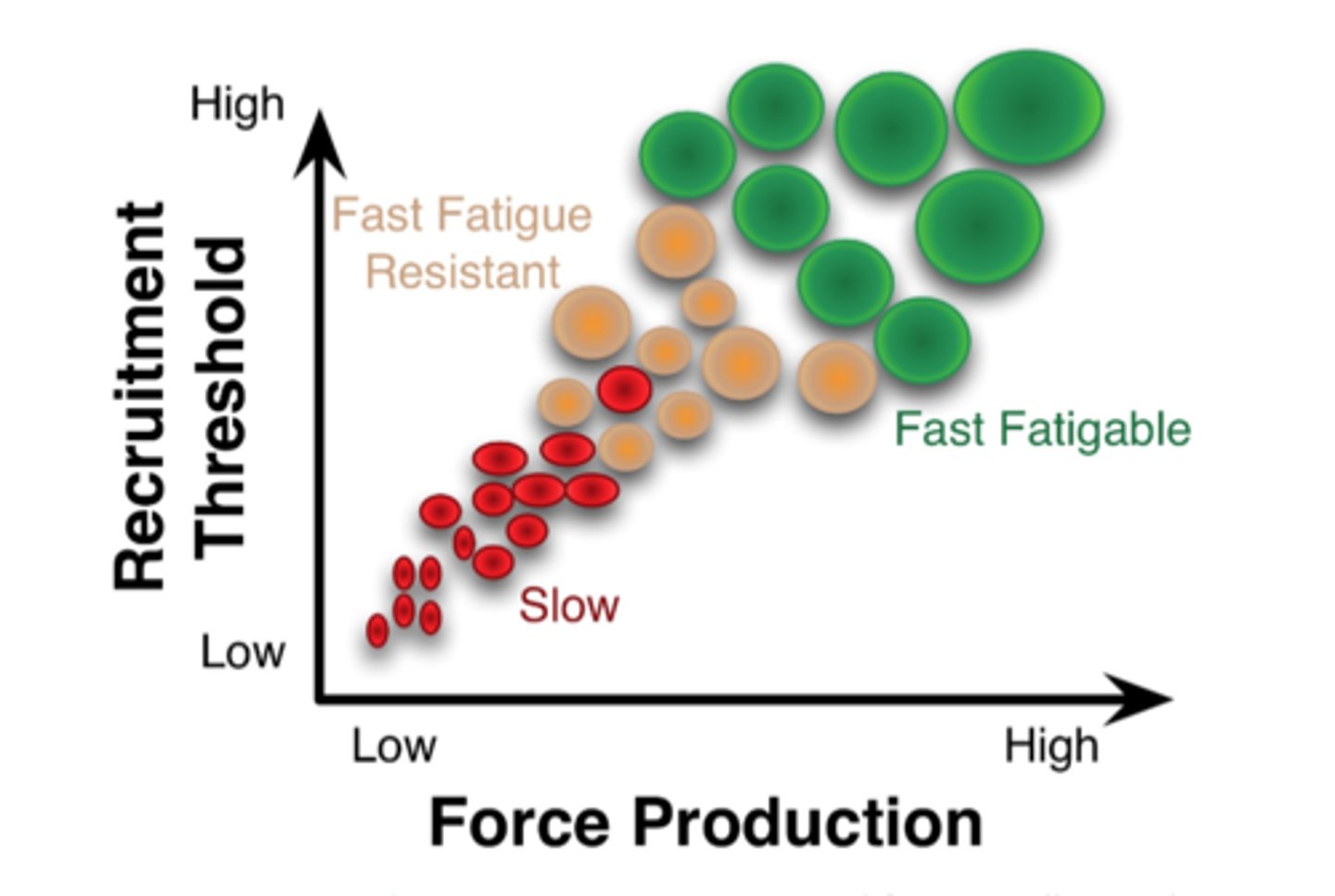
When using electrical stimulation, does recruitment follow Henneman Size principle?
No- electrical stimulation will recruit largest motor units first.
Decruitment
motor units decruit large to small (inverse from Henneman Recruitment)
Size and Threshold
smaller motor units have a lower threshold than large ones
Twitch
the response to a single action potential
Summation
the increase tension (increase in force) due to multiple stimuli
Tetanus
sustained maximal tension (contraction) due to high frequency stimulation (no more increase force when increase in stimulus)
Graded maximal contraction
each MU is recruited at its threshold force level AND THEN its stimulation frequency is increased.
only way for smooth contraction.
Graded Contraction Firing Patterns
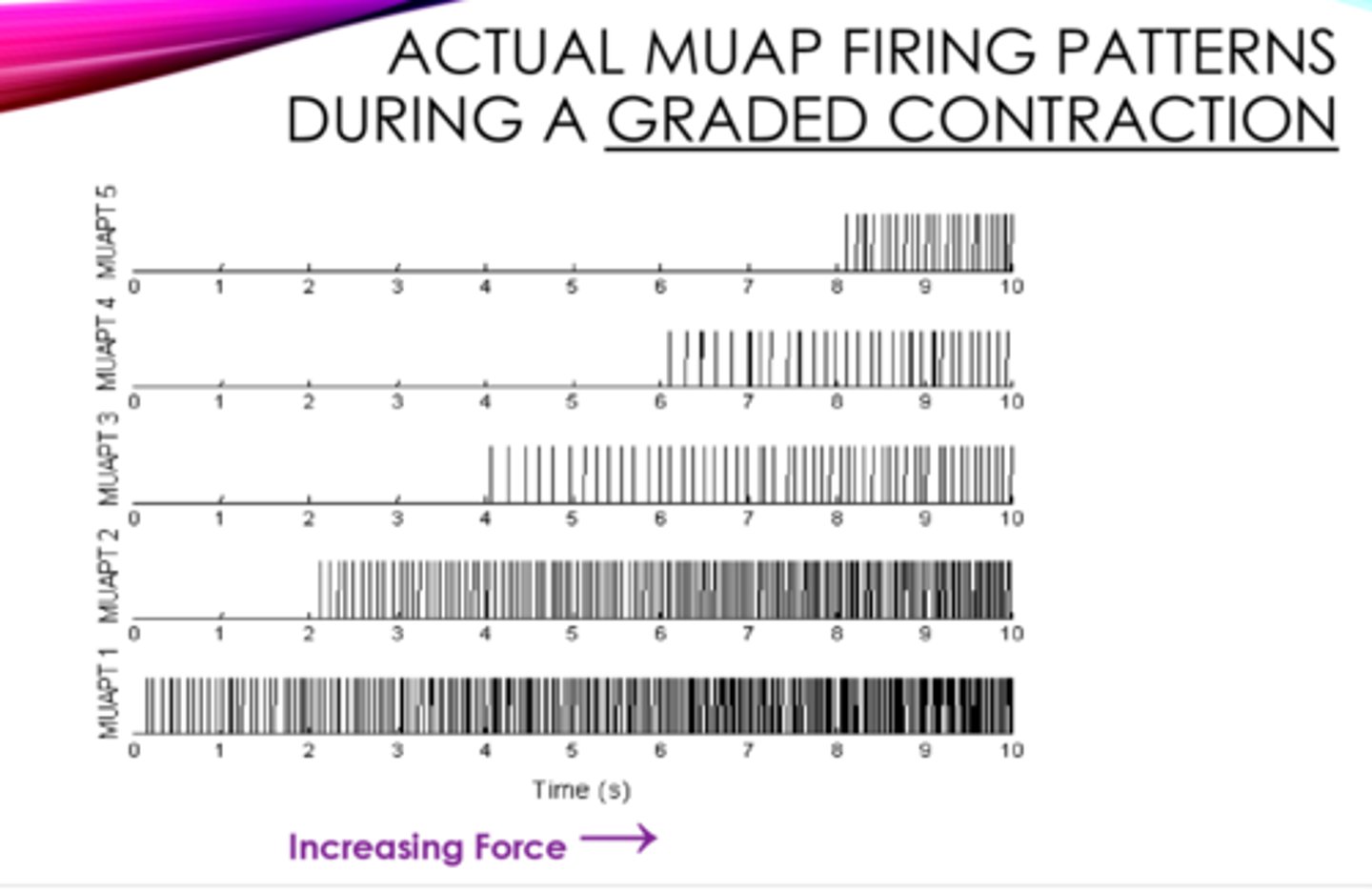
Graded contractions graph
recruitment and rate coding doesn't happen without the other
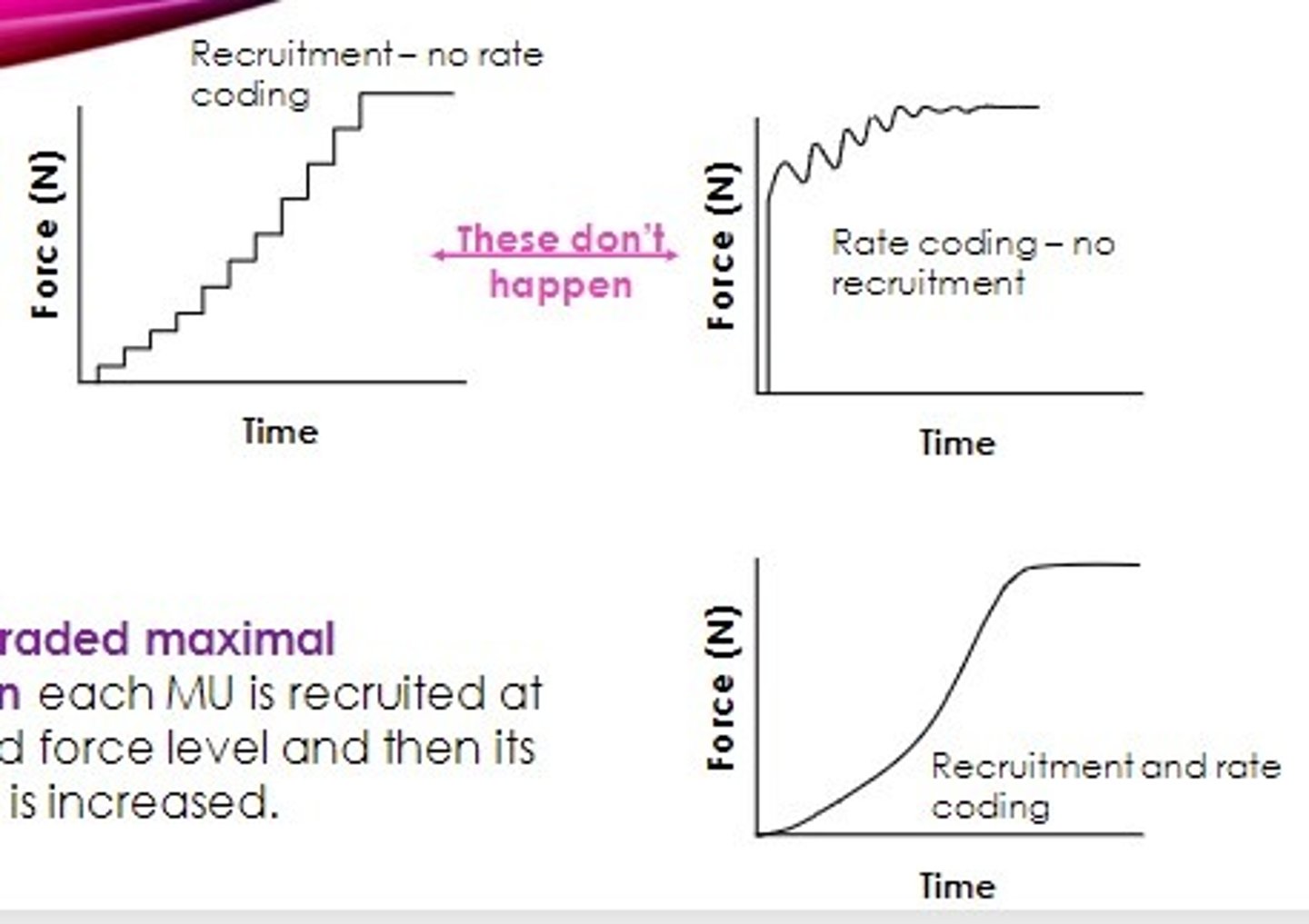
Recruitment Exceptions
motor units decrease their threshold as the movement gets more ballistic, and the motor units can fire synchronously
Electromyography
- refers to the electric activity in the muscle
- NOT related to force, just stimulation
What is responsible for improvement in the first 8-12 weeks of training?
Neural Factors
Examples of neural factors responsible for initial improvement
-improved innervation
-learning to control all MUs
-eliminating antagonistic activity (overriding GTO feedback)
-increased synchronization of MUs.
When does hypertrophy occur after training from an untrained state?
after 12 weeks
understand strength gains graph
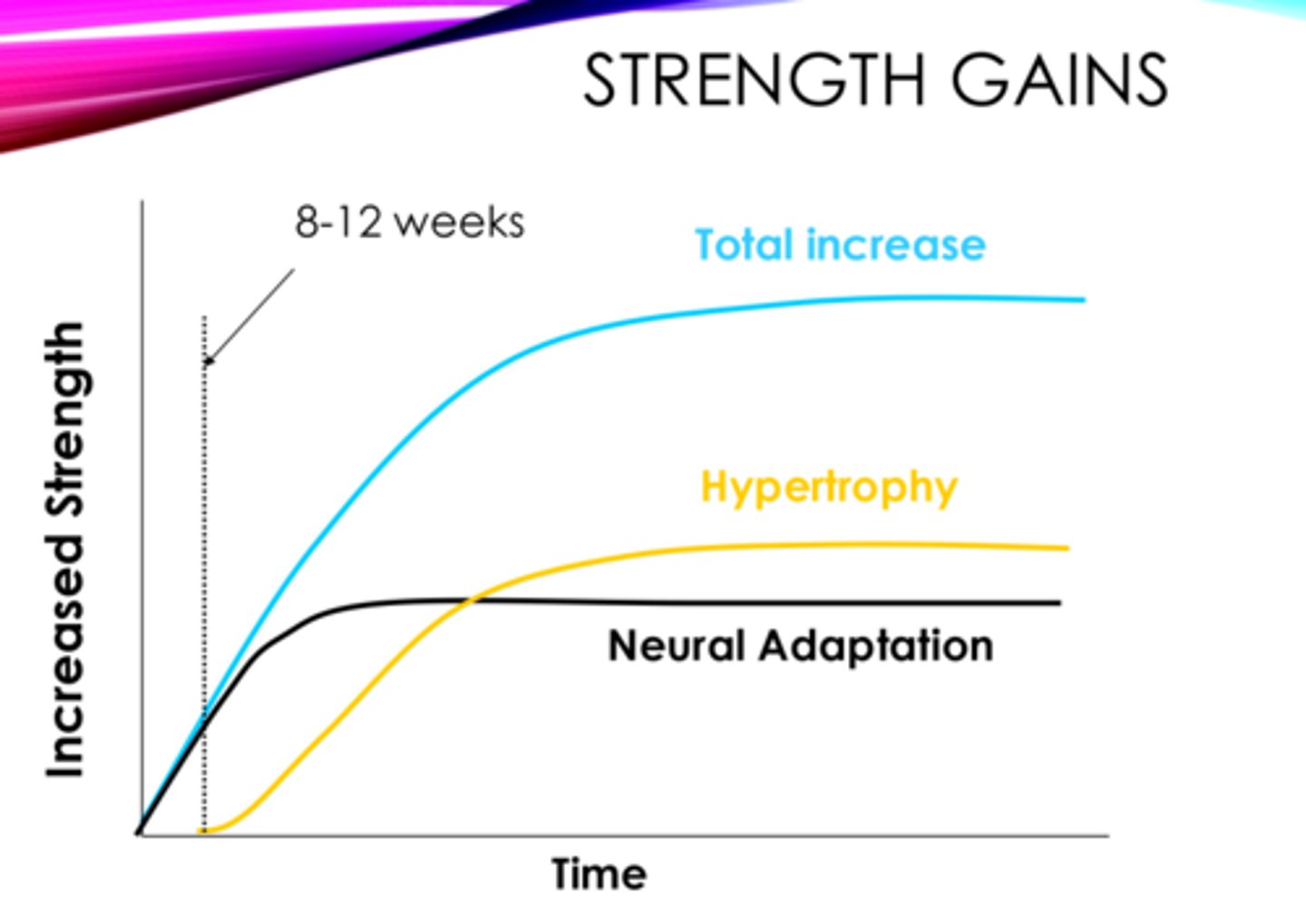
Factors affecting torque
1. level of stimulation (recruitment, rate coding)
2. muscle fiber type
3. muscle architecture (PCSA, tendon-to-tendon length)
4. muscle velocity
5. muscle length
6. neural mechanisms (SS cycle, GTO)
7. moment arms and angle
Level of stimulation
-percent of activation
-recruitment
-rate coding
-most important to affecting torque
muscle architecture
-PCSA
-tendon-to-tendon length
Neural Mechanisms
-stretch-shortening cycle
-muscle spindles
-GTO
moment arms (d)
angle of pull
larger moment arm = larger torque
the sequence of muscular contraction (technique)
important for maximal performance of dynamic movements
-nervous system is responsible for the "when" of muscle activation.
-shotput
-start with larger muscles that are further away, last thing active is the wrist